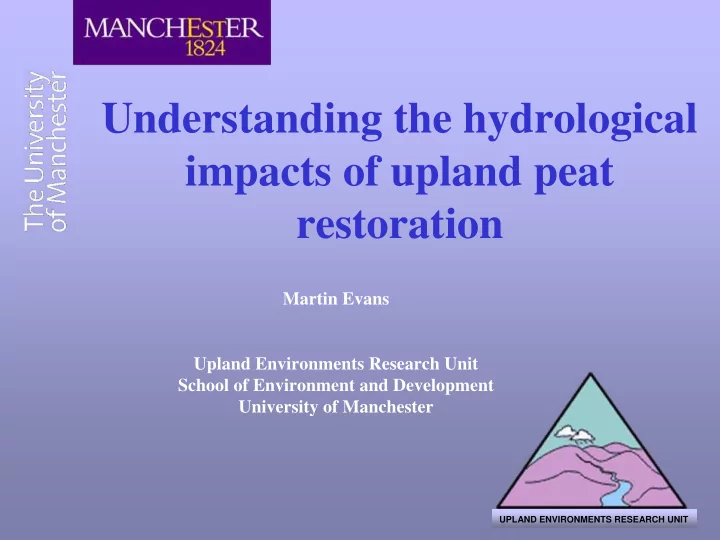

Understanding the hydrological impacts of upland peat restoration Martin Evans Upland Environments Research Unit School of Environment and Development University of Manchester UPLAND ENVIRONMENTS RESEARCH UNIT
‘The Badlands of Britain’ (Tallis, 1997) UK has 15% of world resource of blanket peatlands but much of it is severely eroded
The blanket peat erosion mosaic
Moorland Restoration and Hydrology • Bleaklow Restoration • Reseeding with utility grass seed, lime and fertiliser • Heather Brash
Progress of re-vegetation over 3 years
What we think we know about upland peatland hydrology Runoff Generation Mechanisms Runoff Pathways Runoff Timing and Magnitude
Relation between runoff and water table
Runoff and water table Trout Beck, Moor House Upper North Grain, Intact (Evans et al 1999) Bleaklow, Eroded (Daniels et al 2008)
Runoff Pathways Source Mean and standard deviation contribution to total plot runoff % Overland Flow 84.47 (18.61) 1-5 cm depth flow 17.76 (18.64) 5-10 cm depth flow 0.74 (1.77) 10-50 cm depth flow 0.03 (0.07) Holden and Burt, 2000
Importance of Pipeflow Holden and Burt, 2001
Runoff Magnitude and Timing – or…are peatlands sponges?
Impact of Moorland Management on Runoff Burnt Hill, Conway and Millar (1960) Order of catchment flashiness is: Drained/burnt eroded Drained Natural Natural
Hydrograph Form • Short Lag Times • Short time to peak • Rapid recession • High ROP
• Rapid Response Annual Regime • Flow closely linked to rainfall patterns
Restoration Study Black Clough (Burnt) Catchments Trenches (bare) Bleaklow Head Joseph (Restored) Weather Station Penguins (control)
Runoff Ratios storm Preci API JN JS P WH D TN TS start p from Bleaklow 3q-07 Micro- 13/08/2007 78.67 17.80 0.24 0.01 0.31 - - 1.13 - catchments 02/09/2007 28.02 24.26 0.38 0.03 0.27 - - 0.85 - 19/09/2007 34.04 15.50 0.21 0.27 0.26 - - 0.51 0.17 21/09/2007 28.62 36.21 0.25 0.40 0.25 - - 0.39 0.22 23/09/2007 30.21 38.80 0.79 0.37 1.05 - - 1.37 1.31 4q-07 07/10/2007 36.37 30.70 0.55 0.00 0.39 - - 0.66 - 27/10/2007 21.31 11.80 0.61 0.04 0.32 - - 1.29 - 07/11/2007 7.42 16.20 0.38 0.00 0.22 - - 1.30 - 08/11/2007 7.42 22.00 0.47 0.17 0.31 - - 1.91 - 10/11/2007 19.80 25.30 0.39 0.06 0.27 - - 1.33 - 20/11/2007 19.60 29.30 0.67 0.02 0.66 - - 1.27 - 27/11/2007 54.96 28.80 0.48 0.05 0.38 - - 0.28 - 05/12/2007 68.24 55.30 0.48 0.09 0.26 - - 1.35 - 2q-08 27/05/2008 2.61 6.10 0.07 - - - - - - 02/06/2008 13.05 33.80 0.37 - 0.38 1.26 0.26 1.87 - 21/06/2008 11.65 17.30 0.67 - 0.26 1.10 0.04 - - 3q-08 16/07/2008 61.19 38.80 0.59 - 0.39 1.13 1.69 - - 17/08/2008 26.64 60.40 0.45 0.03 0.33 1.04 1.12 1.54 - 05/09/2008 57.09 39.90 0.53 - 0.60 - 0.99 - - 12/09/2008 8.44 84.00 0.60 0.30 0.34 1.90 0.80 - 4q-08 07/10/2008 11.86 101.80 0.41 0.16 0.27 2.12 0.81 - - 21/10/2008 16.52 47.50 0.30 0.18 0.32 1.34 0.48 - - Mean 0.45 0.13 0.37 1.41 0.77 1.12 0.57
The Dark Peak Water Table Project 30 Y (relative northing) (m) 20 10 0 0 10 20 30 X (relative easting) (m)
Water table behaviour Date 17/05/2008 11/06/2008 06/07/2008 31/07/2008 25/08/2008 19/09/2008 14/10/2008 08/11/2008 03/12/2008 28/12/2008 22/01/2009 -100.00 0.00 100.00 Water Table Depth (mm) 200.00 F01-01 300.00 A02-01 400.00 B02-01 500.00 600.00 700.00 800.00
Controls on Water table
Extent of gully edge drawdown Distance from Gully (m) 0 2 4 6 8 10 12 14 16 Median Water Table Depth (mm) 0 100 200 NGE 300 NGF 400 NGG 500 NGH 600 700 800
Wetness index and water table
Bare peat and restored (revegetated) sites Does restoration affect water table?
Water tables at bare peat and restored sites Wetness Index 2.71 4.36 2.74 3.91 Modelled WT (mm) 518 143 508 214
Re-vegetation and Runoff Velocity Holden et al 2008 Water Resources Research
Research questions • If restoration raises water tables – What is the mechanism – evaporation? – Effect on runoff generation and ROP? • If restoration reduces overland flow velocities – Effect on timing of runoff delivery • Need to examine the full water balance of restoration sites.
Conclusions • Whilst peatlands do not act as a sponge as commonly envisaged there are hydrological benefits to moorland restoration. There are also potential mechanisms by which moorland restoration might mitigate runoff • The key to understanding these effects at the site scale is integrated monitoring of the full catchment water balances at restoration sites –initial work planned as part of MS4W • Upscaling site scale understanding remains a major research challenge • Doubtful that hydrological degradation is fully reversible – gullies and pipes
Re-vegetating Eroding Intact Low POC Losses High POC Losses Reduced Carbon Storage Carbon sequestration High water Low water table/Runoff table/ mitigation? Increased runoff?
Recommend
More recommend